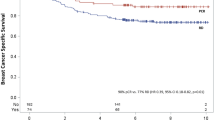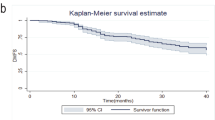Abstract
In order to evaluate the outcome of patients with breast cancer according to response after primary therapy and according to clinical and biologic baseline features, we identified patients who were treated with preoperative therapy and who underwent surgery at the European Institute of Oncology (IEO), Milan, Italy, between 1995 and 2006. The outcome of patients who achieved pathological complete remission (pCR) and patients with residual disease (RD) at final surgery was analyzed. Of the 687 patients treated with preoperative therapy, we identified 82 patients who achieved pCR (12%) and 605 patients with RD (88%). A statistically significant difference in disease-free survival (DFS), distant disease-free survival (DDFS), and overall survival (OS) was observed for patients with pCR compared with those who had RD (5 year DFS 73% vs. 59% P = 0.029; 5 year DDFS 81% vs. 72% P = 0.085; 5 year OS 88% vs. 77% P = 0.033). At the multivariate analysis, for patients achieving pCR, large tumor size (>5 cm) correlated with worse DFS (HR 3.18; 95% CI 1.34–7.51); clinical nodal involvement was associated with poorer DFS and DDFS (HR 6.94; 95% CI 1.62–29.73 and HR 9.87 95% CI 1.29–75.53, respectively). pCR after preoperative systemic therapy correlated with significant improved outcome. A substantial rate of relapse was observed for patients with large tumors and with clinical nodal involvement at baseline. Further improvement in adjuvant treatment might be warranted.





Similar content being viewed by others
References
Fisher B, Bryant J, Wolmark N et al (1998) Effect of preoperative chemotherapy on the outcome of women with operable breast cancer. J Clin Oncol 16:2672–2685
Guarneri V, Broglio K, Kau SW et al (2006) Prognostic value of pathologic complete response after primary chemotherapy in relation to hormone receptor status and other factors. J Clin Oncol 24:1037–1044
Hennessy BT, Hortobagy GN, Rouzier RN et al (2005) Outcome after pathologic complete eradication of cytologically proven breast cancer axillary node metastases following primary chemotherapy. J Clin Oncol 23:9304–9311
Kuerer HM, Newman LA, Smith TM et al (1999) Clinical course of breast cancer patients with complete pathologic primary tumor and axillary lymph node response to doxorubicin-based neoadjuvant chemotherapy. J Clin Oncol 17:460–469
Colleoni M, Viale G, Zahrieh D et al (2004) Chemotherapy is more effective in patients with breast cancer not expressing steroid hormone receptors: a study of preoperative treatment. Clin Cancer Res 10:6622–6628
Rouzier R, Pusztai L, Delaloge S et al (2004) Nomograms to predict pathologic complete response and metastasis-free survival after preoperative chemotherapy for breast cancer. J Clin Oncol 22:2294–2302
Liedtke C, Mazouni C, Hess KR et al (2008) Response to neoadjuvant therapy and long term survival in patients with triple negative breast cancer. J Clin Oncol 26:1274–1281
Bear HD, Anderson S, Brown A et al (2003) The effect on tumor response of adding sequential preoperative docetaxel to preoperative doxorubicin and cyclophosphamide: preliminary results from National Surgical Adjuvant Breast and Bowel Project Protocol B-27. J Clin Oncol 21:4165–4174
Perou CM, Sorlie T, Eisen MB et al (2000) Molecular portraits of human breast tumors. Nature 406(6797):747–752
de Ronde JJ, Hannemann J, Halfwerk H et al (2010) Concordance of clinical and molecular breast cancer subtyping in the context of preoperative chemotherapy response. Breast Cancer Res Treat 119(1):119–126
Cheang MC, Chia SK, Voduc D et al (2009) Ki67 index, HER2 status, and prognosis of patients with luminal B breast cancer. J Natl Cancer Inst 101(10):736–750
Hugh J, Hanson J, Chon M et al (2009) Breast cancer subtypes and response to docetaxel in node positive breast cancer: use of an immunohistochemical definition in the BCIRG 001 trial. J Clin Oncol 27:1168–1176
McShane LM, Altman DG, Sauerbrei W et al (2006) Reporting recommendations for tumor marker prognostic studies (REMARK). Breast Cancer Res Treat 100:229–235
Colleoni M, Orvieto E, Nolè F et al (1999) Prediction of response to primary chemotherapy for operable breast cancer. Eur J Cancer 35:574–579
Goldhirsch A, Glick JH, Gelber RD et al (1998) Meeting highlights: international consensus panel on the treatment of primary breast cancer. J Natl Cancer Inst 90:1601–1608
Wolmark N, Wang J, Mamounas E et al (2001) Preoperative chemotherapy in patients with operable breast cancer: nine-year results from the National Surgical Adjuvant Breast and Bowel Project B-18. J Natl Cancer Inst Monogr 30:96–102
Chollet P, Amat S, Cure H et al (2002) Prognostic significance of a complete pathological response after induction chemotherapy in operable breast cancer. Br J Cancer 86:1041–1046
Gonzalez-Angulo AM, McGuire SE, Buchholz TA et al (2005) Factors predictive of distant metastases in patients with breast cancer who have a pathologic complete response after neoadjuvant chemotherapy. J Clin Oncol 23:7098–7104
Dawood S, Broglio K, Kau S-W et al (2008) Prognostic value of initial clinical disease stage after achieving pathological complete response. Oncologist 13:6–15
Author information
Authors and Affiliations
Corresponding author
Rights and permissions
About this article
Cite this article
Montagna, E., Bagnardi, V., Rotmensz, N. et al. Pathological complete response after preoperative systemic therapy and outcome: relevance of clinical and biologic baseline features. Breast Cancer Res Treat 124, 689–699 (2010). https://doi.org/10.1007/s10549-010-1027-4
Received:
Accepted:
Published:
Issue Date:
DOI: https://doi.org/10.1007/s10549-010-1027-4




